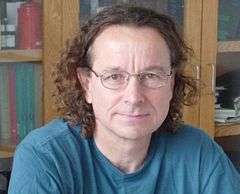Roderick MacKinnon
| Roderick MacKinnon | |
|---|---|
 | |
| Born |
19 February 1956 Burlington, Massachusetts, USA |
| Nationality | United States |
| Fields | Chemistry |
| Alma mater | Brandeis University |
| Known for | Potassium Channel Structure |
| Notable awards |
Newcomb Cleveland Prize (1997) Albert Lasker Award for Basic Medical Research (1999) Perl-UNC Prize (2001) Nobel Prize in Chemistry (2003) Louisa Gross Horwitz Prize (2003) |
Roderick MacKinnon (born 19 February 1956) is a professor of Molecular Neurobiology and Biophysics at Rockefeller University who won the Nobel Prize in Chemistry together with Peter Agre in 2003 for his work on the structure and operation of ion channels.[1][2][3]
Biography
Early life and education
MacKinnon was born in Burlington, Massachusetts and initially attended the University of Massachusetts Boston. MacKinnon then transferred to Brandeis University after one year, and there he received a bachelor's degree in biochemistry in 1978, studying calcium transport through the cell membrane for his honors thesis in Christopher Miller's laboratory. It was also at Brandeis where MacKinnon met his future wife and working-colleague Alice Lee.[4]
After receiving his degree from Brandeis, MacKinnon entered medical school at Tufts University.[3] He got his M.D. in 1982 and received training in Internal Medicine at Beth Israel Hospital in Boston. He did not feel satisfied enough with the medical profession, so in 1986 he returned to Christopher Miller's laboratory at Brandeis for postdoctoral studies.[4]
Career
In 1989 he was appointed assistant professor at Harvard University where he studied the interaction of the potassium channel with a specific toxin derived from scorpion venom, acquainting himself with methods of protein purification and X-ray crystallography. In 1996 he moved to Rockefeller University as a professor and head of the Laboratory of Molecular Neurobiology and Biophysics where he started to work on the structure of the potassium channel. These channels are of particular importance to the nervous system and the heart and enable potassium ions to cross the cell membrane.
Scientific contributions
Potassium channels demonstrate a seemingly counterintuitive activity: they permit the passage of potassium ions, whereas they do not allow the passage of the much smaller sodium ions. Before MacKinnon's work, the detailed molecular architecture of potassium channels and the exact means by which they conduct ions remained speculative. In 1998, despite barriers to the structural study of integral membrane proteins that had thwarted most attempts for decades, MacKinnon and colleagues determined the three-dimensional molecular structure of a potassium channel from an actinobacteria, Streptomyces lividans, utilizing X-ray crystallography. With this structure and other biochemical experiments, MacKinnon and colleagues were able to explain the exact mechanism by which potassium channel selectivity occurs.[5][6]
His prize-winning research was conducted primarily at the Cornell High Energy Synchrotron Source (CHESS) of Cornell University, and at the National Synchrotron Light Source (NSLS) of Brookhaven National Laboratory.[7]
In 2007 he became a foreign member of the Royal Netherlands Academy of Arts and Sciences.[8]
Business Activities
MacKinnon is co-inventor of two patent applications (US Application 20120027693US application 20140343156) related to the targeting of ion channels for the treatment of muscle cramps. MacKinnon is also a co-founder and serves on the board of directors for Flex Pharma, a biotechnology company researching therapies targeting TRPA1 channels for the treatment of cramps, multiple sclerosis, and amyotrophic lateral sclerosis.[9][10] The company had a $86 million initial public offering in 2015.[11] In 2016, Flex Pharma released the consumer product "HotShot" as an anti-cramping shot for endurance athletes.[12]
References
- ↑ "2003 Nobel Prize in Chemistry Awarded to Researcher Roderick MacKinnon". Brookhaven National Labs. October 8, 2003. Retrieved 11 February 2010.
- ↑ "Nobel Prize honors Rockefeller University scientist Roderick MacKinnon for revealing process of electrical signaling in humans and other living organisms". The Rockefeller University. October 8, 2003. Retrieved 11 February 2010.
- 1 2 Birmingham K (June 2001). "Rod MacKinnon". Nat. Med. 7 (6): 648. doi:10.1038/89005. PMID 11385491.
- 1 2 MacKinnon, Roderick (October 2003). Editor Tore Frängsmyr, ed. The Nobel Prizes 2003. Stockholm, Sweden: Nobel Foundation. Retrieved 11 February 2010.
- ↑ MacKinnon R, Cohen SL, Kuo A, Lee A, Chait BT (April 1998). "Structural conservation in prokaryotic and eukaryotic potassium channels". Science. 280 (5360): 106–9. Bibcode:1998Sci...280..106M. doi:10.1126/science.280.5360.106. PMID 9525854.
- ↑ Doyle DA, Morais Cabral J, Pfuetzner RA, et al. (April 1998). "The structure of the potassium channel: molecular basis of K+ conduction and selectivity". Science. 280 (5360): 69–77. Bibcode:1998Sci...280...69D. doi:10.1126/science.280.5360.69. PMID 9525859.
- ↑ "The Chemistry of the Cell". Brookhaven National Lab. Retrieved 13 March 2010.
- ↑ "R. MacKinnon". Royal Netherlands Academy of Arts and Sciences. Archived from the original on 13 February 2016. Retrieved 13 February 2016.
- ↑ "A Scientific Solution to (Finally) Stop Muscle Cramps". Outside. 1 September 2015. Retrieved 20 July 2016.
- ↑ "Flex Pharma Pipeline". Flex Pharma. Retrieved 20 July 2016.
- ↑ Garde, Damian (28 January 2015). "Flex Pharma pulls off an $86M IPO for its cramp-treating spice cocktail". Fierce Biotech. Retrieved 20 July 2016.
- ↑ "Fuel Buzz: New HotShot Drink Aimed at Preventing Cramps". Competitor. 2 June 2016. Retrieved 20 July 2016.
External links
- Biography and Bibliographic Resources, from the Office of Scientific and Technical Information, United States Department of Energy
- Interview with Roderick MacKinnon by Harry Kroto Freeview video provided by the Vega Science Trust.
- Website of his lab at The Rockefeller University
- Ion Channel Chemistry: The Electrical System of Life Transcribed video of a May 2008 talk by MacKinnon, sponsored by the Oregon State University Libraries.
- Nobel Lecture by Roderick MacKinnon, 2003
